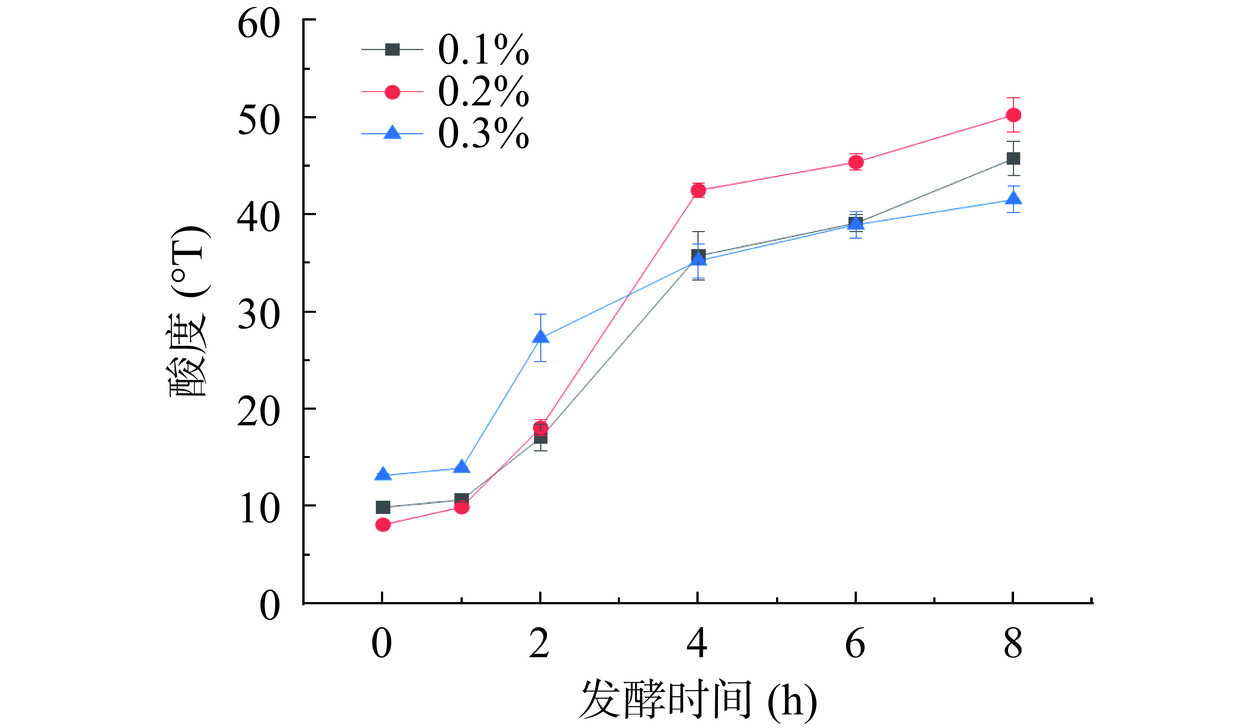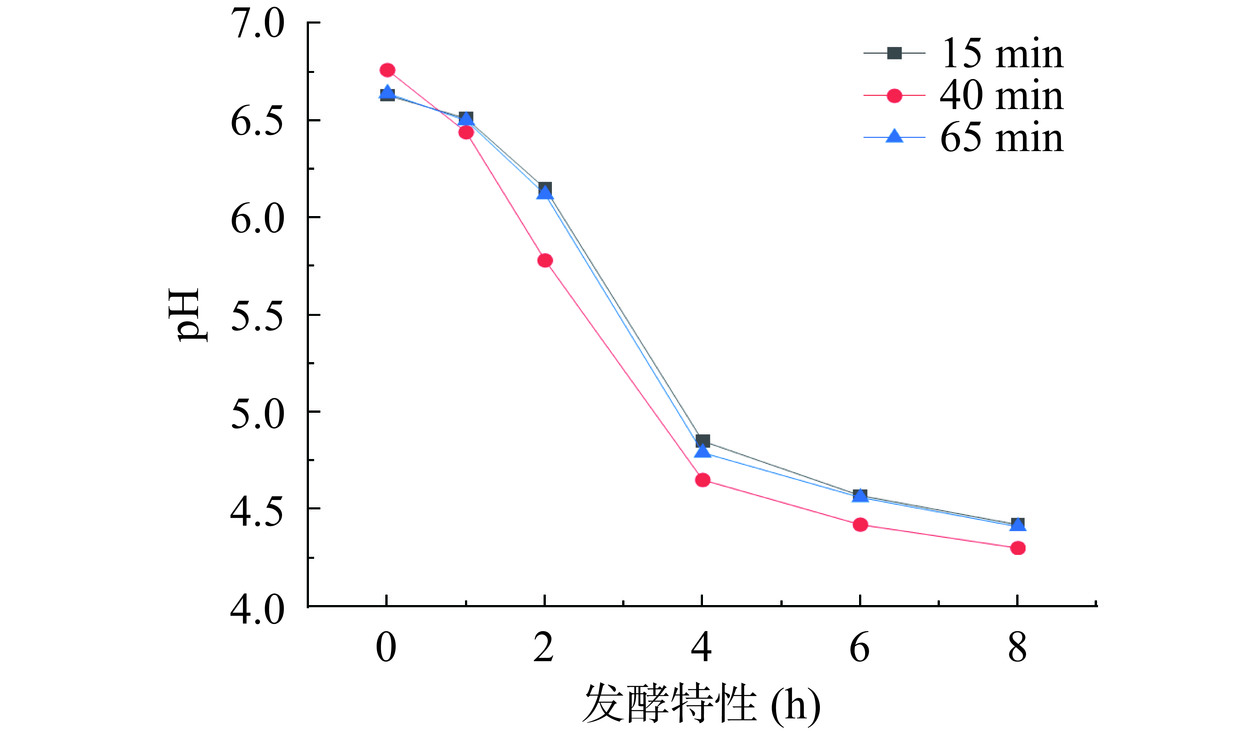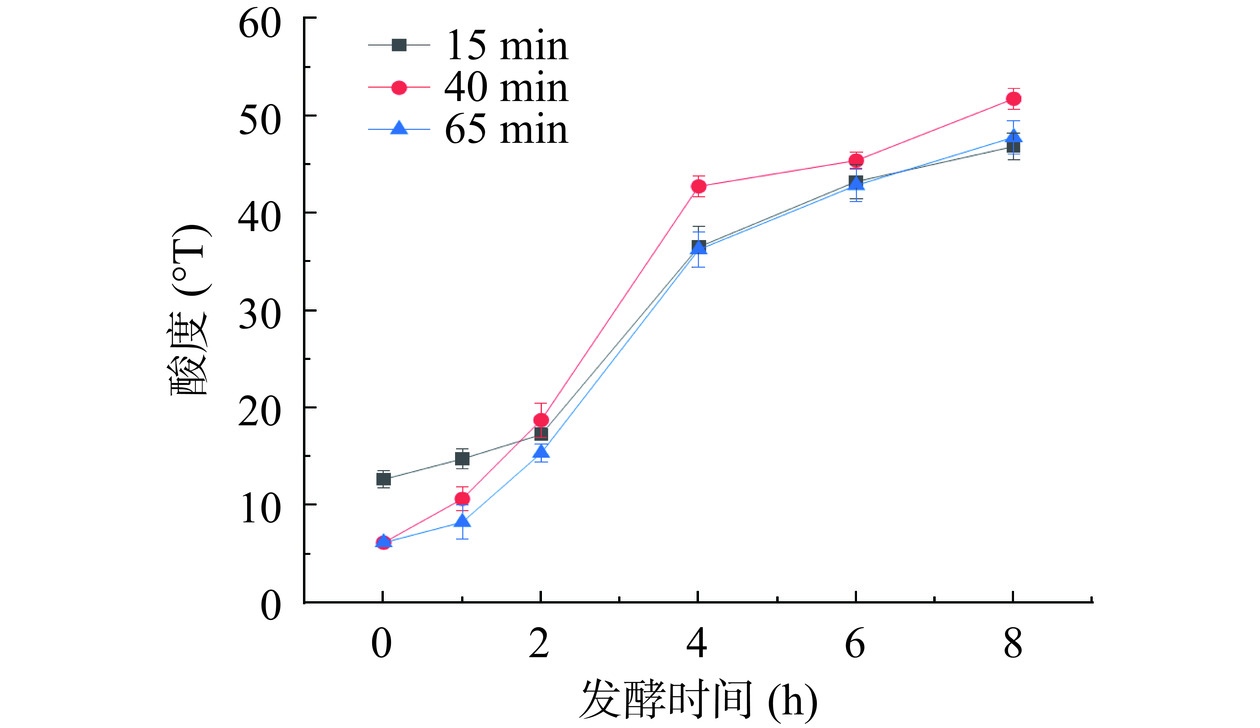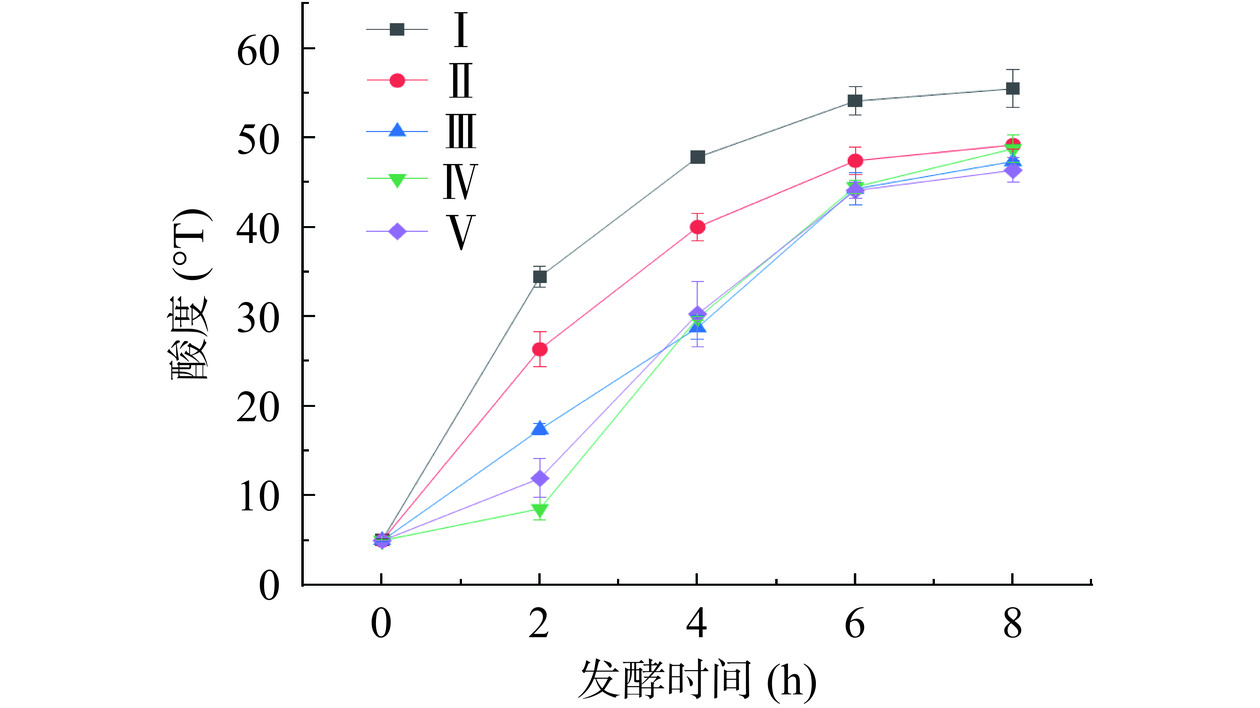Effects of Protein-glutaminase and Starter Cultures on the Quality of Walnut-based Yogurt
-
摘要: 选用核桃仁为原料,制浆后利用蛋白谷氨酰胺酶对其水解,通过调配、均质、灭菌及发酵制备凝固型核桃酸奶。通过对其发酵特性、理化指标及微观形态等方面的分析,研究蛋白谷氨酰胺酶(protein glutaminase,PG)作用条件和5种直投式发酵剂(Ⅰ~Ⅴ)对核桃酸奶品质的改善效果,并将最佳条件下的核桃酸奶与牛乳酸奶对比。结果表明,相较未酶解的核桃乳,酶解后核桃乳制备的酸奶在发酵特性与质构参数方面得到有效改善,其中添加量0.2%(1.35 U/g)、水解40 min为最佳酶解条件,所制得的核桃酸奶pH为4.3,酸度为55°T,硬度达到85.30 g,稠度为583.96 g·s。采用发酵剂Ⅰ制备的核桃酸奶酸度最高,且在储存期21 d内的变化幅度小,而其他发酵剂制备的酸奶出现了不同程度的分层和沉淀。采用发酵剂Ⅰ发酵的酸奶具有更好的粘弹性,且凝胶网络结构更为致密,而发酵剂Ⅳ和Ⅴ发酵的酸奶表观粘度、G'和G''较小,凝胶结构更为松散。此外,采用发酵剂Ⅰ制备的核桃酸奶在储存期内的活菌数始终高于106 CFU/mL。虽然与牛乳酸奶相比,核桃酸奶在稠度、持水力及乳清析出率方面仍有待改善,但总体来说,PG酶解改善了核桃酸奶的凝乳效果,采用发酵剂Ⅰ(保加利亚乳杆菌和嗜热链球菌)制备出的酸奶品质得到提升,整体评价较好。Abstract: Walnut kernels, selected as the raw material, underwent hydrolysis with protein-glutaminase (PG) following pulping. This process laid the foundation for producing set-type walnut yogurt, involving steps such as blending, homogenization, sterilization, and fermentation. The study investigated the impact of protein-glutaminase and five distinct starter cultures labeled I~V on the quality of walnut yogurt. This was evaluated by examining the yogurt's fermentation characteristics, physicochemical indicators, and microstructure. Furthermore, walnut yogurt developed under these optimal conditions was compared to traditional milk yogurt to assess its quality and characteristics. The findings revealed a significant improvement in the fermentation characteristics and textural parameters of yogurt fermented by walnut milk following enzymatic hydrolysis compared to non-enzymatic walnut milk. The optimal conditions were identified as 0.2% enzyme concentration and a 40-minute reaction time, with the pH, acidity, hardness, and consistency of walnut yogurt being 4.3, 55°T, 85.30 g, and 583.96 g·s, respectively. Walnut yogurt developed using starter culture I exhibited the highest acidity level, maintaining minimal fluctuation over a 21-day storage period. In contrast, yogurts prepared with alternative starter cultures demonstrated varying degrees of stratification and sedimentation. The yogurt fermented with culture I showed superior viscoelastic properties, presenting a denser gel network. Conversely, yogurts fermented with cultures IV and V displayed reduced apparent viscosity, lower values of G' (storage modulus), and G'' (loss modulus), along with a looser gel structure. Additionally, walnut yogurt produced with starter culture I maintained bacterial counts exceeding 106 CFU/mL throughout the storage duration. Despite walnut yogurt requiring further refinement in aspects such as consistency, water-holding capacity, and whey release rate compared to milk yogurt, the overall impact of PG was positive, enhancing the gelation quality of walnut yogurt. The yogurt prepared with starter culture I (Lactobacillus bulgaricus and Streptococcus thermophilus) was notably improved, receiving favorable overall assessments.
-
植物酸奶不含乳糖和胆固醇,能满足牛乳过敏、环保及动物保护等人群的需求,近年来市场份额呈向上发展趋势。核桃酸奶作为一种创新型植物酸奶,营养价值高,是蛋白质、不饱和脂肪酸与磷脂的良好来源。谷蛋白是核桃蛋白的主要成分,然而该蛋白含有大量酰胺基团,溶解性较差[1],易受环境因素影响而变性,导致核桃乳体系经加热、高压等加工后因破乳引发体系失稳,或在发酵中因出现蛋白沉淀、脂肪上浮的分层现象而无法形成凝乳均匀的凝固型酸奶。蛋白质谷氨酰胺酶(protein glutaminase,PG)来源于一种由日本科学家从土壤中分离出的产PG酶的菌株,可特异性水解蛋白中的酰胺基、改善蛋白质的溶解性及乳化性等功能特性、有效提高乳体系的稳定性,在食品工业中极具发展潜力[2−3]。研究表明,PG酶可明显提高小麦面筋的溶解性,且不改变蛋白分子量,使其形成稳定的高内相乳液[4]。燕麦蛋白、大豆蛋白经PG酶处理后溶解性和乳化性皆得到改善[5−6]。PG酶还具有改善风味的作用,譬如可明显降低豌豆蛋白的豆腥味和苦味[7]。此外,有学者已将PG酶用于牛乳酸奶加工中。Miwa等[8]发现,PG酶可使无脂和低脂酸奶的凝胶网络结构变得更加致密,表面的析水率降低;Wu等[9]发现PG酶改善了凝固型脱脂酸奶的质地(硬度、稠度、持水力)和感官特性。然而,有关PG酶脱酰胺改善核桃酸奶品质的报道却较少。
发酵剂的选择关乎核桃酸奶的发酵特性,适合在核桃乳基质中生长繁殖的乳酸菌可以缩短核桃酸奶抵达发酵终点的时间,同时提高产酸量[10]。此外,T/WSJD 12-2020《植物蛋白饮料 植物酸奶》规定,植物酸奶中的乳酸菌活菌数需要达到106 CFU/mL。直投式发酵剂是经高效浓缩而成,具备活菌含量高、防止菌种污染和老化、适合长期保藏等优势[10]。不同原料的植物乳体系中适合生长的菌种不同,因此需要对发酵剂进行针对性筛选,以改善酸奶品质。马文艺等[10]从6种不同直投式发酵剂中筛选出了适合豌豆蛋白的发酵剂,优化了豌豆酸奶的风味;林浩鹏等[11]研究发现在9种商品发酵剂中,7菌发酵出的核桃酸奶具有更加优良的品质。
目前,植物酸奶大多为植物原料和动物乳、奶粉等混合发酵而成,缺乏有关纯植物基酸奶的研究。本文以核桃仁为原料,采用蛋白质谷氨酰胺酶和5种商业发酵剂制备了凝固型核桃酸奶,根据理化、流变、微观结构及感官评价,筛选出最佳酶解条件和发酵剂种类。同时,将最佳条件下制得的产品与牛乳酸奶比较,进一步评价其品质改善效果,以寻求未来突破的方向,为促进核桃资源利用拓展新思路。
1. 材料与方法
1.1 材料与仪器
核桃仁 摩尔农庄生物科技有限公司;酸奶发酵剂Ⅰ(2菌,保加利亚乳杆菌、嗜热链球菌) 丹尼克斯;酸奶发酵剂Ⅱ(5菌,嗜热链球菌、保加利亚乳杆菌等) 昆山佰生优生物科技有限公司;酸奶发酵剂Ⅲ(10菌,嗜热链球菌、保加利亚乳杆菌、嗜酸乳杆菌等)、酸奶发酵剂Ⅳ(30菌,保加利亚乳杆菌、嗜热链球菌、乳双歧杆菌等)、酸奶发酵剂Ⅴ(50菌,保加利亚乳杆菌、嗜热链球菌、乳双歧杆菌等) 青岛优比特生物技术有限公司;蛋白谷氨酰胺酶(673 U/g) 日本天野酶制剂株式会社;白砂糖、纯牛奶 市售;MRS固体培养基 北京陆桥技术股份有限公司。
CR21GIII冷冻离心机 日本Hitachi公司;AH-2010均质机 上海多宁生物科技股份有限公司;JG3521.888酸奶发酵机 施威朗电器(深圳)有限公司;BMJ-250C电热恒温培养箱 上海博迅医疗生物仪器股份有限公司;FD100A高压蒸汽灭菌锅 厦门致微仪器有限公司;TA.XTPlus质构仪 英国SMS公司;MCR301 旋转流变仪 奥地利安东帕有限公司;SU8100电子显微镜 日立高新技术(上海)国际贸易有限公司。
1.2 实验方法
1.2.1 酸奶制备工艺
1.2.1.1 核桃酸奶的制备
磨浆:将脱皮核桃仁与水按照1:3榨汁磨浆,磨浆时间为4 min(2 min/次),得到核桃乳。
酶解、离心:添加蛋白质谷氨酰胺酶(PG)0.1%~0.3%(0.67~2.02 U/g)于核桃乳中,在温度60 ℃下酶解15~65 min;随后95 ℃灭酶2 min,冷却后在2000 r/min的转速下离心5 min。
调配、均质、灭菌:取上层液体加入8%蔗糖,搅拌均匀后于20 MPa下均质2次;之后在65 ℃下灭菌30 min。
接种:待冷却至40 ℃左右,接种发酵剂Ⅰ~Ⅴ,接种量为0.2%(w/v)。
发酵:发酵温度为42 ℃,时间为6~8 h,所得酸奶在4 ℃下保藏12 h。
1.2.1.2 牛乳酸奶的制备
在市售纯牛奶中加入8%蔗糖后,通过65 ℃灭菌30 min,待冷却后接种0.2%发酵剂Ⅰ,在42 ℃下发酵8 h,所得酸奶在4 ℃下保藏12 h。
1.2.2 PG酶解条件的筛选
1.2.2.1 PG酶添加量的筛选
将添加量为0.1%,0.2%,0.3%(0.67、1.35、2.02 U/g)的PG酶分别加入核桃乳中,在60 ℃下酶解40 min。后续步骤按照1.2.1.1。
1.2.2.2 PG酶水解时间的筛选
将0.2%(1.35 U/g)添加量的PG酶加入核桃乳中,分别在60 ℃下水解15、40、65 min。后续步骤按照1.2.1.1。
未经PG酶水解的核桃乳会因均质和灭菌导致体系分层,无法进行后续发酵。
1.2.3 pH的测定
pH的测定通过pH计完成。
1.2.4 酸度的测定
根据 GB 5009.239-2016《食品安全国家标准 食品中酸度的测定》。
1.2.5 质构特性测定
根据马文艺等[10]的方法,使用Texture Expert Exceed数据分析软件分析核桃酸奶的质构特性,并从中得到以下4种参数:硬度、稠度、内聚性和黏聚指数。每个样品进行6次平行测定。
1.2.6 持水力测定
持水力的测定基于Levy等[12]的方法,称取15 g核桃乳于50 mL离心管中发酵6 h,并于4 ℃中保藏12 h以上,于4 ℃、4000 r/min下离心10 min。称取析出的乳清重量,并通过如下公式计算持水力:
其中,W代表离心管的重量(g);W1代表样品的总重(g);W2代表离心去除乳清后的样品重量(g)。每个样品进行6次平行测定。
1.2.7 乳清析出率测定
乳清析出率的测定基于Miwa等[13]的方法。称取15 g核桃乳于直径为5 cm的发酵盒中发酵6 h,于4 ℃下冷藏12 h后取出,将盒子倾斜45°,小心吸出乳清并称重,并通过下式计算乳清析出率:
其中,W代表离心管的重量(g);W1代表样品的总重(g);W2代表离心去除乳清后的样品重量(g)。每个样品进行6次平行测定。
1.2.8 流变学特性测定
根据Huang等[14]的方法,直径为40 mm的平板,板间隙为1 mm,在0.1%的恒定应变下,在0.1~100 Hz范围内对样品进行频率扫描。粘度通过剪切扫描测定,剪切速率的范围设为0.01~100 s−1。所有样品在25 ℃下进行测量,每个样品平行测定3次。
1.2.9 乳酸菌活菌数的测定
根据GB 4789.2-2016《食品安全国家标准 食品微生物学检验菌落总数测定》。
1.2.10 显微结构观察
参考Chen等[15]的方法,将核桃酸奶凝胶切成10 mm×5 mm×5 mm的凝乳块,加入2.5%戊二醛溶液,于4 ℃浸泡12 h以上。之后,用0.1 mol/L、pH 7.2的PBS缓冲液冲洗6次,再于4 ℃下浸泡15 min。采用乙醇(25%~100%)梯度脱水15 min,其中100%乙醇脱水2次(15 min/次)。再用乙酸异戊酯与无水乙醇的等体积混合溶液浸泡15 min,最后用100%乙酸异戊酯浸泡15 min。冻干,采用离子溅射仪镀金,在电压为5.0 kV的条件下观察显微结构并拍照。
1.2.11 感官评价
参考斯梦等[16]的方法,选取10名同学对凝固型核桃酸奶打分。计算过程中分别去除每项指标的最大和最小值,然后计算剩余分数的平均值,感官评分见表1。
表 1 核桃酸奶的感官评定标准Table 1. Sensory rating standard of set-type walnut yogurt指标(分) 标准 分值(分) 颜色(20) 白色略带淡黄,颜色均一 16~20 白色略带黄色,颜色略均一 11~15 白色偏黄,颜色不均一 6~10 深黄色 0~5 滋味(20) 酸甜适宜,无异味 16~20 偏酸或偏甜 11~15 过酸或过甜 6~10 无味或异味 0~5 气味(20) 核桃的醇香及发酵后的独特酸味,无不愉快气味 16~20 核桃发酵香气略淡,无不愉快气味 11~15 缺乏核桃香气和发酵后的独特酸味,略有杂味 6~10 酸味重或其他杂味 0~5 组织状态(40) 细腻、稳定,无分层、无沉淀,表面未析出乳清 31~40 较为均匀细腻,略有分层,表面略微析出乳清 21~30 不稳定,质地较为脆弱、分层较为明显,体系
析出较多乳清11~20 不稳定,质地脆弱、分层明显,表面析出
非常多的乳清0~10 1.3 数据处理
借助origin软件作图,采用SPSS 22(IBM,美国)进行单因素方差统计分析,P<0.05表示有显著性差异。
2. 结果与分析
2.1 酶解条件的确定
2.1.1 酶添加量的确定
不同PG酶添加量的核桃酸奶在发酵期的不同时段内pH及酸度变化不同。由图1的pH变化曲线可知,8 h发酵结束后,3种核桃酸奶的pH皆小于4.5,且0.2% PG酶处理的核桃乳pH相对更低。由图2可知,前1 h的发酵速率差距不大,而1~2 h内,0.3% PG酶处理的核桃乳发酵速率更快;2 h后,0.2% PG酶处理的核桃乳发酵速率加快,且上升幅度较大,这说明乳酸菌的活性增加,提高了产酸速率;4 h后,3种核桃乳的发酵速率都有所减慢。在发酵终点(8 h),0.2% PG酶处理的核桃酸奶的酸度比其他两种样品高,0.3% PG酶处理的核桃酸奶酸度最低。这说明0.2% PG酶处理的核桃乳体系更适合乳酸菌繁殖产酸。
不同添加量的PG酶对核桃酸奶的质构特性影响不同,主要从硬度、稠度、内聚性和黏性指数4个方面表征,它们可以反映固体酸奶的凝胶强弱、内部紧实程度[10]。本研究结果表明,不加PG酶的核桃乳在高压均质、灭菌受热时会导致蛋白质变性,出现破乳现象,从而无法发酵成体系均匀稳定的酸奶,因此没有相关数据。只有加入PG酶的核桃乳才能发酵成凝固型核桃酸奶。由表2可知,三种核桃酸奶的质构参数由大到小依次为0.2%>0.3%>0.1%,均有显著性差异(P<0.05)。说明核桃酸奶的质构与PG酶添加量关系密切,0.2% PG酶处理的核桃酸奶凝乳效果更好,具有较好的质地;而0.1% PG酶处理的核桃酸奶的硬度最小,凝乳效果不好,质构特性最差。这可能因为PG酶添加较少时,对底物的作用不充分;而随着添加量的加大,PG酶的作用位点增多,对谷蛋白的脱酰胺度增强,脱酰胺后的蛋白质拥有更加灵活的构象[7],使得蛋白质更容易吸附在界面上并进行展开,可溶性蛋白含量由此得到提高[5]。这也是PG酶解后核桃蛋白能稳定地存在于核桃乳中而不是沉淀的原因。而过多的PG酶会在脱酰胺的同时水解更多肽链,增加疏水多肽,进而降低蛋白溶解性,导致凝胶质地变弱[9,17−18]。
表 2 PG酶添加量对核桃酸奶质构特性的影响Table 2. Effects of the addition of PG on the textural characteristics of walnut yogurt2.1.2 酶解时间的确定
PG酶的不同处理时间对核桃酸奶发酵期内的pH和酸度影响不同。核桃酸奶的pH变化如图3所示,在8 h发酵结束后,酶解时间为15、65 min的核桃酸奶pH相差不大,而酶解40 min的核桃酸奶pH最低,并且在1~4 h内,其pH下降最快,说明乳酸菌活性增强,产酸速度增快,有利于在更短的时间内达到发酵终点(pH 4.5)。由图4可知,3种核桃乳在前1 h内的酸度变化不明显,而1~4 h内,3种核桃乳的酸度大幅上升,酶解时间为40 min的样品酸度升高速率最快。当发酵时间达到8 h,3种酸奶的酸度由大到小的次序是40 min>65 min>25 min,这说明PG酶处理40 min的核桃乳更适合作为乳酸菌生长繁殖的基底。
3种酶解时间下,核桃酸奶的硬度越大,稠度、内聚性和黏性指数的绝对值也越大。由表3可知,随着PG酶处理时间的延长,核桃酸奶的硬度和稠度先增大后减小。其中,PG酶处理40 min的样品硬度和稠度最大,说明其形成的凝胶强度更高,网络结构更为致密。PG酶处理15 min的样品质构特性次之,而酶解60 min的核桃酸奶质构特性最差。结合不添加PG酶的核桃乳无法发酵出酸奶来看,PG酶作用后核桃酸奶的质构特性得到明显改善,但处理时间过短或过长均不利于核桃酸奶的质构特性。一方面,这可能因为15 min的作用时间太短,酶解不充分;随着时间的推移,在40 min时PG酶对核桃蛋白的适度水解达到平衡点[17]。另一方面,PG酶可特异性水解蛋白质谷氨酰胺上的酰胺基,将其转变为羧基,通过减少分子内与分子间的氢键,增强了蛋白质分子间的静电排斥,可有效提高蛋白质的溶解性[2]。40 min过后,可能由于PG酶酶解时间过长,导致大部分核桃蛋白脱酰胺,增加了核桃蛋白中带负电荷的羧基基团数量以及它们之间的电荷排斥,进而使核桃蛋白解离度增大而聚集性减弱[9],因此酸奶凝胶质地变差。
表 3 PG酶处理时间对核桃酸奶质构特性的影响Table 3. Effects of the treatment time of PG on the textural characteristics of walnut yogurt酶解时间(min) 硬度(g) 稠度(g·s) 内聚性(g) 黏性指数(g·s) 15 75.86±0.16b 503.59±1.50b −15.48±0.24b −23.54±0.35b 40 85.30±0.30a 583.96±0.94a −19.53±0.15c −25.68±0.23c 65 42.71±0.54c 256.79±0.21c −13.47±0.39a −13.80±0.66a 2.2 发酵剂的筛选
2.2.1 发酵剂对核桃酸奶发酵特性的影响
T/WSJD 12-2020《植物蛋白饮料 植物酸奶》中要求,植物酸奶的pH≤4.5,酸度≥30°T[10]。在核桃乳中接种相同添加量的发酵剂Ⅰ~Ⅴ进行发酵,观察核桃酸奶的状态并测定其发酵特性。发酵期间pH变化曲线见图5。由图5可知,发酵剂Ⅰ在发酵期间pH下降最快,其次是发酵剂Ⅱ,虽然发酵剂Ⅲ、Ⅳ、Ⅴ在2 h后活性明显提升,但整体发酵速率相对较慢。这可能和菌种对糖度、糖的种类等方面的适应能力和活性有关。由于核桃中主要的糖分是蔗糖、葡萄糖等二糖,不含乳糖[16];若菌种缺乏分解相应二糖的酶系或这一能力有限,均会导致其生长缓慢或产酸少[19]。另外,有报道称不同乳酸菌对糖度的耐受度不同,相对高添加量的蔗糖产生的渗透压可能会使其生长和产酸减慢[20]。发酵剂Ⅰ号和Ⅱ号发酵剂在核桃乳中适应期短,能够快速繁殖,将糖分转换成乳酸,另外3种发酵剂需要经过一段适应期才能适应核桃乳体系,开始产酸。当发酵时间为6 h时,发酵剂Ⅰ和Ⅱ的pH皆小于4.5,略低于发酵剂Ⅲ、Ⅳ、Ⅴ,说明发酵剂Ⅰ和Ⅱ可以更快达到发酵终点(pH4.5)。发酵6 h时,5种酸奶的发酵速率均变得平缓。由图6可知,在发酵期间,发酵剂Ⅰ和Ⅱ的发酵速率始终快于发酵剂Ⅲ、Ⅳ、Ⅴ;发酵8 h后,发酵剂Ⅱ~Ⅴ制作的核桃酸奶总酸度接近(在47°T左右),而发酵剂Ⅰ制备的核桃酸奶总酸度最高,达到55°T。
酸奶的后酸化会导致保质期短、风味不良和酸味,这将影响酸奶的品质和消费者喜爱度[21]。分别对5种酸奶在储藏期间pH和酸度进行检测,以确定二者的变化,如果酸奶的酸度下降过多,则说明乳酸菌在储藏期内仍持续产酸。由图7和图8可知,在0~21 d内,发酵剂Ⅳ制备的核桃酸奶pH和酸度变化最明显,这体现在其pH从第0 d的4.4降到第21 d的4.15,酸度从47°T升高到63°T。发酵剂Ⅰ的pH和酸度略有变化,pH从4.3降到4.23,酸度由55°T上升到60°T。发酵剂Ⅱ、Ⅲ和Ⅴ的pH和酸度在储存期内变化不明显,但酸度欠缺,这就无法提供酸奶典型的“酸味”。由此可见,Ⅰ更适合作为核桃酸奶的发酵剂。
2.2.2 发酵剂对核桃酸奶质构特性的影响
不同发酵剂对核桃酸奶的质构特性影响不同。由表4可知,由发酵剂Ⅰ制备的核桃酸奶硬度和稠度最大,其次分别是发酵剂Ⅲ和Ⅱ,Ⅴ的硬度最小,这与它们的内聚性和黏聚指数绝对值的变化趋势相同,且表现出显著性差异(P<0.05)。说明发酵剂Ⅰ不仅能够制备出凝乳效果较好的核桃酸奶,而且相比于其他样品,有更高的稠度,这有益于核桃酸奶的品质的优化。
表 4 不同发酵剂对核桃酸奶质构特性的影响Table 4. Effects of starter culture on the textural characteristics of walnut yogurt发酵剂 硬度(g) 稠度(g·s) 内聚性(g) 黏性指数(g·s) Ⅰ 89.85±0.51a 567.44±0.44a −18.63±0.11c −23.68±0.23d Ⅱ 87.14±0.07b 563.86±0.40b −17.99±0.12bc −17.40±0.36ab Ⅲ 85.38±0.34b 554.26±1.90c −17.45±0.28bc −20.54±0.35c Ⅳ 82.59±0.20c 525.18±0.21e −15.12±0.04a −16.37±0.10a Ⅴ 79.34±0.22d 547.41±0.23d −15.89±0.18a −15.03±0.21a 2.2.3 发酵剂对核桃酸奶流变性质的影响
不同发酵剂对核桃酸奶流变学特性的影响如图9所示。所有样品的表观粘度均随剪切速率的增加呈下降趋势。表观黏度(图9a)在0.01~1 s−1之间明显下降,表现出非牛顿流体的特征,并在1 s−1之后趋于平稳。这是因为分子或颗粒运动或排列的方向打破了布朗运动产生的随机效应,导致剪切变稀[22]。随着剪切速率的增加,酸奶中分子的运动逐渐朝着稳定的方向,表观粘度平稳。发酵剂Ⅰ制备的核桃酸奶初始表观粘度(5047 Pa·s)与Ⅱ(5367 Pa·s)相近,而随着剪切速率的增加,发酵剂Ⅱ的表观黏度逐渐低于发酵剂Ⅰ,说明其凝胶网络结构在剪切作用下破坏程度更大。发酵剂Ⅲ、Ⅳ、Ⅴ的表观黏度远小于发酵剂Ⅰ和Ⅱ,表明在发酵剂中,并不是菌的数量、种类越多,发酵出的酸奶品质越好。
为了进一步探究核桃酸奶的凝胶网络交联的强度,分别测定了5种样品的粘弹性响应,G'(储存模量)和G''(损耗模量)分别代表样品内部结构的弹性特征和粘性特征,用于间接模拟口腔咀嚼并反映酸奶的质地[23]。如图9b和图9c可见,5种核桃酸奶的G'远大于G'',说明它们表现出弹性特征,具有类似固体的性质[24−25]。在相同的频率下,G'和G''的大小顺序为Ⅰ>Ⅱ>Ⅲ>Ⅳ>Ⅴ。这可能和不同乳酸菌对核桃乳中营养物质的不同代谢作用有关,大分子蛋白含量较高会有助于凝胶食品表现出粘弹性行为[26]。如果酸奶内部水分含量较高,导致样品表现出较弱的粘弹性;或者,发酵剂菌种组成较多,互相之间竞争营养成分,所产生的代谢产物可能会干扰凝胶网络的形成[26]。
2.2.4 发酵剂对核桃酸奶微观结构的影响
不同发酵剂制备的核桃酸奶在5000倍下的电镜扫描图见图10。由图10a和图10b可知,发酵剂Ⅰ、Ⅱ的凝胶网状结构的孔隙整体较小且较为致密,网孔整体分布也较为均匀。图10c和图10d,发酵剂Ⅲ的结构较为致密,发酵剂Ⅳ的网络结构松散、存有较多空洞;图10e中,发酵剂Ⅴ的网络结构最为疏松,孔径大且分布不均。凝胶网络结构的致密情况与蛋白质相互作用有关,蛋白质相互作用弱,会导致凝胶网络在形成过程中交联度差[27]。这也解释了发酵剂Ⅲ、Ⅳ、Ⅴ的弹性和粘性模量偏低的原因,进一步佐证这3种发酵剂制备的核桃酸奶凝胶性能较差。由此,Ⅰ更有利于发酵质地较好的核桃酸奶,这与上述质构及流变特性分析结果一致。
2.2.5 发酵剂在核桃酸奶中的活菌数
由表5可知,在0~21 d内,发酵剂Ⅰ和Ⅱ制备的核桃酸奶活菌数始终超过1×106 CFU/mL。发酵剂Ⅲ和Ⅳ制备的核桃酸奶分别从第7和14 d开始,乳酸菌数就已经减少到了1×106 CFU/mL以下,而发酵剂Ⅴ在第0 d的活菌数只有9.5×105 CFU/mL,不符合团体标准的规定。这可能是因为菌的种类越多,不同菌之间会发生竞争作用,而营养物质有限,所以导致弱势菌的数量较少。由此,发酵剂Ⅰ更适合作为核桃酸奶的发酵剂。
表 5 不同发酵剂发酵产品的活菌数(CFU/mL)Table 5. Bacterial counts of walnut yogurt fermented with different starter cultures (CFU/mL)发酵剂 0 d 7 d 14 d 21 d Ⅰ 5.0×106b 2.8×106b 1.7×106b 1.2×106b Ⅱ 6.5×106a 3.0×106a 2.1×106a 1.5×106a Ⅲ 3.0×106d 6.8×105d 3.5×105d 4.7×104d Ⅳ 3.2×106c 1.5×106c 8.0×105c 4.8×105c Ⅴ 9.5×105e 8.5×105d 7.2×105c 5.2×105c 2.2.6 感官评价
图11为不同发酵剂制得的核桃酸奶外观。根据颜色、滋味、气味、组织状态对5种发酵剂制备的核桃酸奶进行感官评价,对应分数如表6所示。发酵剂Ⅰ、Ⅳ制备的样品在颜色方面的得分显著高于发酵剂Ⅱ、Ⅲ、Ⅴ。Ⅰ在滋味上的得分最高,其次是Ⅱ,这与乳酸菌活性有关,当其可适应发酵基质并生长繁殖,则会产生酸奶的特征滋味“酸味”,与体系中残留糖产生的“甜味”相互配合,贡献了酸甜的滋味。Ⅰ的气味得分最高,但与其他4种酸奶得分无显著性差异(P>0.05)。组织状态的评价结果显示,Ⅰ的得分最高,口感更醇厚,且与Ⅱ、Ⅲ、Ⅳ、Ⅴ具有显著性差异(P<0.05)。Ⅲ、Ⅳ、Ⅴ分别发生了明显的分层,上层凝乳较好,但下层比较稀薄、颗粒感明显。可见,不同发酵剂对核桃酸奶的感官特性影响不同,主要影响核桃酸奶的滋味、颜色和组织状态,对气味的影响较小。Ⅲ、Ⅳ、Ⅴ的乳酸菌种类虽然多于Ⅰ,但是它们在核桃乳体系中的生长繁殖状况、产酸和凝乳效果并不理想,导致样品各项指标偏低。因此,发酵剂Ⅰ制备的核桃酸奶感官评价最佳。
表 6 5种发酵剂制备的核桃酸奶的感官评分Table 6. Sensory rating of walnut yogurt prepared with 5 starter cultures样品 颜色(分) 滋味(分) 气味(分) 组织状态(分) Ⅰ 15.67±0.58a 18.00±1.00a 14.67±1.15a 28.33±1.53a Ⅱ 13.33±1.53bc 15.33±0.58ab 11.00±1.73a 23.33±2.08b Ⅲ 12.67±0.58c 13.00±3.46b 9.67±1.15a 22.67±1.53b Ⅳ 15.00±0.00ab 14.67±0.58ab 10.33±0.58a 19.67±2.08c Ⅴ 12.40±1.40c 12.00±1.73b 9.33±4.16a 16.67±2.31c 2.3 核桃酸奶与牛乳酸奶的对比
为进一步评价PG酶和发酵剂Ⅰ对核桃酸奶的品质改善效果,将其与牛乳酸奶进行对比,以寻求需深入研究的方向。
2.3.1 核桃酸奶与牛乳酸奶的凝胶性质
用市售纯牛奶按照相同的条件接种、发酵,分别测定并对比了核桃酸奶与牛乳酸奶的0,7,14,21 d的硬度、稠度、持水力和乳清析出率,如图12所示。图12a和图12b反映出,在0~21 d内,牛乳酸奶和核桃酸奶的硬度相差不大,但是牛乳酸奶的稠度却大于核桃酸奶(相差20 g·s左右)。这可能和不同蛋白质的功能特性及糖的种类有关,酪蛋白是牛乳中的主要蛋白质,具有良好的溶解性和胶凝性,且牛乳中存在乳糖,更容易被乳酸菌利用,可发酵出更细腻、稠度更高的酸奶[28]。
如图12c和图12d,持水力和乳清析出率是评价凝固型酸奶品质的重要指标。酸奶的持水力越高,析水率越低,说明酸奶的凝胶网络结构越致密、稳定性越高,对水分子的束缚作用越强[28]。乳清析出率也反映了凝胶网络的稳定性。如果凝胶结构弱化,就会导致蛋白分子发生重排,进而引发酸奶内部结构对水的截留能力降低,因此乳清会在自然状态下从凝胶表面析出[29−30]。核桃酸奶在0~21 d内持水力从70%下降到68%,而牛乳酸奶在相同时间内持水力始终保持在85%~86%,优于核桃酸奶。核桃酸奶在0~21 d内,乳清析出率从8.20%增加到8.83%,而牛乳酸奶的乳清析出率在0.1%以下。与未添加PG酶的核桃乳无法发酵成酸奶相比,上述结果说明PG酶处理能一定程度改善核桃蛋白的溶解度,促进其形成凝胶,但核桃酸奶凝胶网状结构对水的束缚能力仍然较弱。因此,仍需探索乳清析出的影响因素及降低核桃酸奶乳清析出率的方法。
2.3.2 核桃酸奶与牛乳酸奶的微观结构
核桃酸奶与牛乳酸奶在5000倍下的电镜扫描图见图13。核桃酸奶相比于牛乳酸奶,网络结构显得更加粗糙,且孔隙尺寸相对较大。牛乳酸奶的网络结构更加致密,且孔隙更小、分布更加均匀。报道指出致密的网络结构有利于对水分子的束缚[31],这也进一步解释了核桃酸奶的持水力低于牛乳酸奶,而乳清析出率高于牛乳酸奶的原因。
3. 结论
核桃乳中蛋白质溶解性较差,易在加热、高压均质、发酵过程中破乳或变性,且因缺乏乳糖,无法制备出品质优良的酸奶。本文对核桃蛋白进行适度酶解,并通过筛选适合在核桃乳中生长的直投式发酵剂以改善核桃酸奶的酸度、质构、流变特性、微观结构及感官评价。研究发现:PG酶水解核桃乳,可改善核桃酸奶的酸度及质构特性,最佳酶解条件为添加量0.2%(1.35 U/g),作用时间40 min;发酵剂Ⅰ可以赋予核桃酸奶较佳的理化特性、流变特性、活菌数,且样品感官评价较好;与牛乳酸奶相比,经适度酶解及发酵剂Ⅰ制备的植物基核桃酸奶有着与其相似的硬度、稠度,但是持水力和乳清析出率略逊色,因此仍需探索其他改善核桃酸奶品质的方法。总之,通过适度PG酶处理及发酵剂Ⅰ发酵制备出的核桃酸奶酸甜可口,适合素食主义、牛乳过敏等人群食用。
-
表 1 核桃酸奶的感官评定标准
Table 1 Sensory rating standard of set-type walnut yogurt
指标(分) 标准 分值(分) 颜色(20) 白色略带淡黄,颜色均一 16~20 白色略带黄色,颜色略均一 11~15 白色偏黄,颜色不均一 6~10 深黄色 0~5 滋味(20) 酸甜适宜,无异味 16~20 偏酸或偏甜 11~15 过酸或过甜 6~10 无味或异味 0~5 气味(20) 核桃的醇香及发酵后的独特酸味,无不愉快气味 16~20 核桃发酵香气略淡,无不愉快气味 11~15 缺乏核桃香气和发酵后的独特酸味,略有杂味 6~10 酸味重或其他杂味 0~5 组织状态(40) 细腻、稳定,无分层、无沉淀,表面未析出乳清 31~40 较为均匀细腻,略有分层,表面略微析出乳清 21~30 不稳定,质地较为脆弱、分层较为明显,体系
析出较多乳清11~20 不稳定,质地脆弱、分层明显,表面析出
非常多的乳清0~10 表 2 PG酶添加量对核桃酸奶质构特性的影响
Table 2 Effects of the addition of PG on the textural characteristics of walnut yogurt
表 3 PG酶处理时间对核桃酸奶质构特性的影响
Table 3 Effects of the treatment time of PG on the textural characteristics of walnut yogurt
酶解时间(min) 硬度(g) 稠度(g·s) 内聚性(g) 黏性指数(g·s) 15 75.86±0.16b 503.59±1.50b −15.48±0.24b −23.54±0.35b 40 85.30±0.30a 583.96±0.94a −19.53±0.15c −25.68±0.23c 65 42.71±0.54c 256.79±0.21c −13.47±0.39a −13.80±0.66a 表 4 不同发酵剂对核桃酸奶质构特性的影响
Table 4 Effects of starter culture on the textural characteristics of walnut yogurt
发酵剂 硬度(g) 稠度(g·s) 内聚性(g) 黏性指数(g·s) Ⅰ 89.85±0.51a 567.44±0.44a −18.63±0.11c −23.68±0.23d Ⅱ 87.14±0.07b 563.86±0.40b −17.99±0.12bc −17.40±0.36ab Ⅲ 85.38±0.34b 554.26±1.90c −17.45±0.28bc −20.54±0.35c Ⅳ 82.59±0.20c 525.18±0.21e −15.12±0.04a −16.37±0.10a Ⅴ 79.34±0.22d 547.41±0.23d −15.89±0.18a −15.03±0.21a 表 5 不同发酵剂发酵产品的活菌数(CFU/mL)
Table 5 Bacterial counts of walnut yogurt fermented with different starter cultures (CFU/mL)
发酵剂 0 d 7 d 14 d 21 d Ⅰ 5.0×106b 2.8×106b 1.7×106b 1.2×106b Ⅱ 6.5×106a 3.0×106a 2.1×106a 1.5×106a Ⅲ 3.0×106d 6.8×105d 3.5×105d 4.7×104d Ⅳ 3.2×106c 1.5×106c 8.0×105c 4.8×105c Ⅴ 9.5×105e 8.5×105d 7.2×105c 5.2×105c 表 6 5种发酵剂制备的核桃酸奶的感官评分
Table 6 Sensory rating of walnut yogurt prepared with 5 starter cultures
样品 颜色(分) 滋味(分) 气味(分) 组织状态(分) Ⅰ 15.67±0.58a 18.00±1.00a 14.67±1.15a 28.33±1.53a Ⅱ 13.33±1.53bc 15.33±0.58ab 11.00±1.73a 23.33±2.08b Ⅲ 12.67±0.58c 13.00±3.46b 9.67±1.15a 22.67±1.53b Ⅳ 15.00±0.00ab 14.67±0.58ab 10.33±0.58a 19.67±2.08c Ⅴ 12.40±1.40c 12.00±1.73b 9.33±4.16a 16.67±2.31c -
[1] KONG X Z, ZHANG L N, LU X, et al. Effect of high-speed shearing treatment on dehulled walnut proteins[J]. LWT-Food Science and Technology,2019,116:108500. doi: 10.1016/j.lwt.2019.108500
[2] ZHANG G Q, MA S J, LIU X, et al. Protein-glutaminase:Research progress and prospect in food manufacturing[J]. Food Bioscience,2021,43:101314. doi: 10.1016/j.fbio.2021.101314
[3] CHEN X, FU W Y, LUO Y C, et al. Protein deamidation to produce processable ingredients and engineered colloids for emerging food applications[J]. Comprehensive Reviews in Food Science and Food Safety,2021,20(4):3788−3817. doi: 10.1111/1541-4337.12759
[4] MA S J, LIU X, ZHOU J W, et al. Characterization of high internal phase emulsions stabilized by protein glutaminase-deamidated wheat gluten[J]. LWT-Food Science and Technology,2023,179:114622. doi: 10.1016/j.lwt.2023.114622
[5] ZHONG Q J, SONTAG S T, SALOVAARA H, et al. Oat protein solubility and emulsion properties improved by enzymatic deamidation[J]. Journal of Cereal Science,2015,64:126−132. doi: 10.1016/j.jcs.2015.04.010
[6] JIANG Y Q, WANG Z J, HE Z Y, et al. Effect of heat-induced aggregation of soy protein isolate on protein-glutaminase deamidation and the emulsifying properties of deamidated products[J]. 2022, 154:112328.
[7] FANG L Y, XIANG H, SUN-WATERHOUSE D X, et al. Enhancing the usability of pea protein isolate in food applications through modifying its structural and sensory properties via deamidation by glutaminase[J]. Agricultural and Food Chemistry,2020,68:1691−1697. doi: 10.1021/acs.jafc.9b06046
[8] MIWA N, YOKOYAMA K, WAKABAYASHI H, et al. Effect of deamidation by protein-glutaminase on physicochemical and functional properties of skim milk[J]. International Dairy Journal,2010,20(6):393−399. doi: 10.1016/j.idairyj.2009.12.015
[9] WU J J, DAI T, LIN R Y, et al. Effect of protein-glutaminase on the texture, rheology, microstructure and sensory properties of skimmed set-type yoghurt[J]. Food Chemistry,2023,429:136831. doi: 10.1016/j.foodchem.2023.136831
[10] 马文艺, 李兴飞, 刘军, 等. 制浆工艺和发酵剂分别对豌豆浆风味和豌豆酸奶品质的影响[J]. 食品与发酵工业,2021,47(20):188−193. [MA W Y, LI X F, LIU J, et al. The effects of pulping process and starter on the flavor of pea milk and the quality of pea yogurt respectively[J]. Food and Fermentation Industries,2021,47(20):188−193.] MA W Y, LI X F, LIU J, et al. The effects of pulping process and starter on the flavor of pea milk and the quality of pea yogurt respectively[J]. Food and Fermentation Industries, 2021, 47(20): 188−193.
[11] 林浩鹏, 刘亚琼, 梁梦帆, 等. 商品发酵剂对凝固型核桃酸奶品质的影响研究[J]. 中国乳品工业,2020,48(4):61−64. [LIN H P, LIU Y Q, LIANG M F, et al. Study on the effect of commercial starter on the quality of solidified walnut yoghurt[J]. China Dairy Industry,2020,48(4):61−64.] LIN H P, LIU Y Q, LIANG M F, et al. Study on the effect of commercial starter on the quality of solidified walnut yoghurt[J]. China Dairy Industry, 2020, 48(4): 61−64.
[12] LEVY R, OKUN Z, DAVIDOVICH-PINHAS M, et al. Utilization of high-pressure homogenization of potato protein isolate for the production of dairy-free yogurt-like fermented product[J]. Food Hydrocolloids,2021,113:106442. doi: 10.1016/j.foodhyd.2020.106442
[13] MIWA N, NIO N, SONOMOTO K. Effect of enzymatic deamidation by protein-glutaminase on the textural and microstructural properties of set yoghurt[J]. International Dairy Journal,2014,36(1):1−5. doi: 10.1016/j.idairyj.2013.12.002
[14] HUANG K, LIU Y Y, ZHANG Y, et al. Formulation of plant-based yoghurt from soybean and quinoa and evaluation of physicochemical, rheological, sensory and functional properties[J]. Food Bioscience,2022,49:101831. doi: 10.1016/j.fbio.2022.101831
[15] CHEN B F, ZHAO X J, CAI Y J, et al. Incorporation of modified okara-derived insoluble soybean fiber into set-type yogurt:structural architecture, rheological properties and moisture stability[J]. Food Hydrocolloids,2023,137:108413. doi: 10.1016/j.foodhyd.2022.108413
[16] 斯梦, 孔祥珍, 张彩猛, 等. 不同糖类和蛋白质浓度对核桃乳发酵及其感官特性的影响[J]. 食品与发酵工业,2022,48(21):111−117. [SI M, KONG X Z, ZHANG C M, et al. Effects of sugar varieties and protein concentration on fermentation and sensory characteristics of fermented walnut milk[J]. Food and Fermentation Industries,2022,48(21):111−117.] SI M, KONG X Z, ZHANG C M, et al. Effects of sugar varieties and protein concentration on fermentation and sensory characteristics of fermented walnut milk[J]. Food and Fermentation Industries, 2022, 48(21): 111−117.
[17] 孙乾. 改性对核桃谷蛋白结构表征及功能特性的影响[D]. 乌鲁木齐:新疆农业大学, 2019. [SUN Q. Effects of modification on structural characterization and functional properties of walnut glutenin[D]. Urumqi:Xinjiang Agricultural University.] SUN Q. Effects of modification on structural characterization and functional properties of walnut glutenin[D]. Urumqi: Xinjiang Agricultural University.
[18] ZHAO J, BHANDARI B, GAIANI C, et al. Physicochemical and microstructural properties of fermentation-induced almond emulsion-filled gels with varying concentrations of protein, fat and sugar contents[J]. Current Research in Food Science,2021,4:577−587. doi: 10.1016/j.crfs.2021.08.007
[19] 李锋, 华欲飞. 应用不同类型的大豆蛋白制备大豆酸奶[J]. 无锡轻工大学学报,2004,23(3):61−64. [LI F, HUA Y F. Different types of soy protein were used to prepare soy yogurt[J]. Journal of Wuxi University of Light Industry,2004,23(3):61−64.] LI F, HUA Y F. Different types of soy protein were used to prepare soy yogurt[J]. Journal of Wuxi University of Light Industry, 2004, 23(3): 61−64.
[20] 韩芸娇, 梁玲, 邱雯雯, 等. 费氏丙酸杆菌与乳酸菌混合发酵酸奶研究[J]. 中国食品学报,2017,17(3):96−103. [HAN Y J, LIANG L, QIU W W, et al. Studies on fermented yogurt using Propionibacterium freudenreichii and Lactobacillus[J]. Journal of Chinese Institute of Food Science and Technology,2017,17(3):96−103.] HAN Y J, LIANG L, QIU W W, et al. Studies on fermented yogurt using Propionibacterium freudenreichii and Lactobacillus[J]. Journal of Chinese Institute of Food Science and Technology, 2017, 17(3): 96−103.
[21] SHORI A B, ALJOHANI G S, AL-ZAHRANI A J, et al. Viability of probiotics and antioxidant activity of cashew milk-based yogurt fermented with selected strains of probiotic Lactobacillus spp.[J]. LWT-Food Science and Technology,2022,153:112482. doi: 10.1016/j.lwt.2021.112482
[22] GHARAIE Z, AZIZI M H, BARZEGAR M, et al. Gum tragacanth oil/gels as an alternative to shortening in cookies:Rheological, chemical and textural properties[J]. LWT-Food Science and Technology,2019,105:265−271. doi: 10.1016/j.lwt.2019.02.025
[23] CUI H T, LI J, XU X Y, et al. Enzymatic interesterification of beef tallow/coconut oil blends to produce a superior margarine base stock[J]. International Journal of Food Science and Technology,2021,57(2):908−919.
[24] MASALOVA I, KAPIAMBA F, TSHILUMBU N, et al. Shear stability of highly concentrated emulsions[J]. Colloid Journal,2018,80(1):54−58. doi: 10.1134/S1061933X18010064
[25] KLOST M, RIBES G G, DRUSCH S. Enzymatic hydrolysis of pea protein:Interactions and protein fractions involved in fermentation induced gels and their influence on rheological properties[J]. Food Hydrocolloids,2020,105:105793. doi: 10.1016/j.foodhyd.2020.105793
[26] XU X Y, CUI H T, YUAN Z H, et al. Effects of different combinations of probiotics on rheology, microstructure, and moisture distribution of soy materials-based yogurt[J]. Journal of Food Science,2022,87(7):2820−2830. doi: 10.1111/1750-3841.16204
[27] 吴俊霞, 程建明, 薛峰. 枸杞大豆蛋白植物基酸奶理化性质研究[J]. 食品与发酵工业,2023,49(10):193−198. [WU J X, CHENG J M, XUE F. Physiochemical properties of plant-based yogurt prepared by wolfberry and soy protein[J]. Food and Fermentation Industries,2023,49(10):193−198.] WU J X, CHENG J M, XUE F. Physiochemical properties of plant-based yogurt prepared by wolfberry and soy protein[J]. Food and Fermentation Industries, 2023, 49(10): 193−198.
[28] 韩永佳. 功能型酸奶的理化特性、抗氧化活性及微观结构的研究[D]. 合肥:合肥工业大学, 2016. [HAN Y J. Functional of yogurt on the physicochemical properties, antioxidant activity, and microstructure were studied[D]. Hefei:Hefei University of Technology, 2016.] HAN Y J. Functional of yogurt on the physicochemical properties, antioxidant activity, and microstructure were studied[D]. Hefei: Hefei University of Technology, 2016.
[29] MIELE N A, CABISIDAN E K, BLAIOTTA G, et al. Rheological and sensory performance of a protein-based sweetener (MNEI), sucrose, and aspartame in yogurt[J]. International Dairy Journal,2017,100(12):9539−9550.
[30] GILBERT A, RIOUX L E, ST-GELAIS D, et al. Characterization of syneresis phenomena in stirred acid milk gel using low frequency nuclear magnetic resonance on hydrogen and image analyses[J]. Food Hydrocolloids,2020,106:105907. doi: 10.1016/j.foodhyd.2020.105907
[31] JØRGENSEN C E, ABRAHAMSEN R K, RUKKE E O, et al. Processing of high-protein yoghurt-a review[J]. International Dairy Journal,2019,88:42−59. doi: 10.1016/j.idairyj.2018.08.002
-
期刊类型引用(0)
其他类型引用(1)





 下载:
下载:













 下载:
下载:



